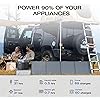









Ready to go? Add this product to your cart and select a plan during checkout. Payment plans are offered through our trusted finance partners Klarna, PayTomorrow, Affirm, Afterpay, Apple Pay, and PayPal. No-credit-needed leasing options through Acima may also be available at checkout.
Learn more about financing & leasing here.
Non-returnable. Transportation of this item is subject to hazardous materials regulation
View our full returns policy here.
Style: DELTA2+220W
Features
Brand: EF ECOFLOW
Wattage: 1024 Watt-hours
Power Source: Solar Powered
Recommended Uses For Product: Camping
Item Weight: 58 Pounds
Voltage: 120 Volts
Output Wattage: 220 Watts
Special Feature: Built to last 6x longer, Huge AC output, Control from anywhere, Expandable capacity, 7x Faster AC charging See more
Included Components: AC charging cable, 220W bifacial foldable solar panel, Solar charging cable, EcoFlow DELTA 2 portable power station, Car charging cable See more
Color: Black
Brand: EF ECOFLOW
Wattage: 1024 Watt-hours
Power Source: Solar Powered
Recommended Uses For Product: Camping
Item Weight: 58 Pounds
Voltage: 120 Volts
Output Wattage: 220 Watts
Special Feature: Built to last 6x longer, Huge AC output, Control from anywhere, Expandable capacity, 7x Faster AC charging
Included Components: AC charging cable, 220W bifacial foldable solar panel, Solar charging cable, EcoFlow DELTA 2 portable power station, Car charging cable
Color: Black
Product Dimensions: 15.7"L x 8.3"W x 11.1"H
Model Name: DELTA 2
Engine Type: Solar
Runtime: 0 minute
Total Power Outlets: 15
Frequency: 60 Hz
Engine Power Maximum: 2700 Watts
Starting Wattage: 2700 Watts
UPC: 842783120823
Manufacturer: DELTA2+220W
Item Weight: 58 pounds
Item model number: EFD330







This is our summary and key points to consider based on customer reviews.
The EcoFlow Delta 2 is praised for its portable convenience, high capacity, and flexibility with power sources. It is described as a game-changer for outdoor activities and emergency situations, capable of handling a range of appliances and devices with ease. Its rapid charging ability, particularly with optional solar panels, is highlighted, alongside its lightweight and manageable size.
Pros
Cons
Should I Buy It?
If you are in need of a reliable, high-capacity, and portable power solution for a variety of settings, the EcoFlow Delta 2 comes highly recommended. Its ability to power a wide range of devices, ease of use, and fast recharging options make it a solid choice. Consider the noise it can produce during high-speed AC charging, but this portable power station appears to tick all the right boxes for most needs.






